British Rail Class 315
The British Rail Class 315 alternating current (AC) electric multiple units (EMU) are National Rail units currently in operation on suburban lines in London. They were built by British Rail Engineering Limited at Holgate Road carriage works from 1980 to 1981, and they were the fifth and final variant of British Rail's then-standard 1972 design for suburban EMUs, which eventually encompassed 755 vehicles and five Classes (Class 313/314/315/507/508). They operate on the 25 kV overhead line and work inner-suburban Transport for London-run services on the Shenfield Metro for TfL Rail, on weekdays only.
| British Rail Class 315 | |
|---|---|
 | |
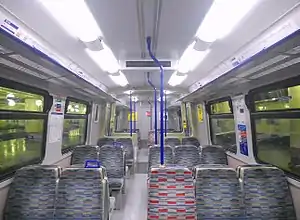 The refreshed interior of a TfL Rail Class 315 | |
| In service | 1980 - present |
| Manufacturer | British Rail Engineering Limited |
| Built at | Holgate Road carriage works |
| Family name | BREL 1972 |
| Replaced | Class 306 |
| Constructed | 1980–1981 |
| Refurbished | 1st refurbishment All 61 sets 2004–2008[1] Bombardier Derby 2nd refurbishment London Overground and TfL Rail 2015–2016 Bombardier Ilford |
| Number built | 61 trainsets |
| Formation | 4 cars per trainset |
| Fleet numbers | 315801–315861 |
| Capacity | 318 seats |
| Operator(s) | TfL Rail |
| Specifications | |
| Car length | 19.80 m (64 ft 11 1⁄2 in) |
| Width | 2.82 m (9 ft 3 in) |
| Height | 3.58 m (11 ft 9 in) |
| Maximum speed | 75 mph (121 km/h)[2] |
| Weight | 127.5 t (125.5 long tons; 140.5 short tons) |
| Power output | 656 kW (880 hp) |
| Acceleration | max. 0.75 m/s2 (2.7 km/(h⋅s); 1.7 mph/s)[2] |
| Electric system(s) | 25 kV 50 Hz AC Overhead |
| Track gauge | 1,435 mm (4 ft 8 1⁄2 in) standard gauge |
Description
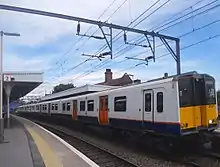
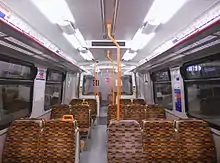
Each complete Class 315 unit is formed of four vehicles with them running for the majority in an 8 car formation with 12 car formations being common if demand is high or the route they are taking is long, such as ones to Southend Victoria or Southminster (operated by Greater Anglia).
The vehicles include: Driving Motor Standard Open (DMSO), Pantograph Trailer Standard Open (PTSO), Trailer Standard Open (TSO), and Driving Motor Standard Open (DMSO). Each DMSO carries four traction motors (315801-841 originally had Brush TM61-53 and 315842-861 had GEC G310AZ, but these motors are interchangeable and nowadays any type can be found on any unit) rated at 110 hp (82 kW) each and a main compressor and air reservoir which carries air for the brakes and suspension. The original pneumatic door system has been replaced by an all-electric door system. The PTSO carries the main and auxiliary transformers, batteries and battery charger, Stone Faiveley AMBR Mk.1 pantograph, vacuum circuit breaker and auxiliary compressor. The TSO carries no equipment other than that which is standard to all coaches.
The coaches only contain standard seating and have no toilet facilities. Car numbering is as follows:
- 64461-64582 - DMSO
- 71281-71341 - PTSO
- 71389-71449 - TSO
Each four-car set is able to seat 318 passengers. The Class 315 units replaced the Class 306 units.
Operations
Historical services
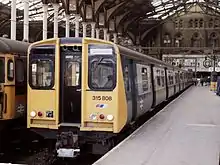
Following the privatisation of British Rail, the Class 315s were divided between First Great Eastern (43 units) and West Anglia Great Northern (18 units). The leasing company Eversholt Rail Group has owned the entire Class 315 fleet since privatisation.[3]
From April 2004, National Express East Anglia (NXEA) ran the inaugural Greater Anglia franchise, which combined the previous operations of both First Great Eastern and WAGN, meaning the two Class 315 fleets were combined. The franchise was initially known as 'One' but was rebranded National Express East Anglia (NXEA) in February 2008.[4]
A refurbishment programme commenced from mid-2004, when National Express East Anglia (then 'One' railway) contracted Bombardier to carry out the refurbishment of all 61 units, starting with the ex-First Great Eastern examples. The low-back 3+2 seating is retained, so the capacity stays the same.[5]
The Class 315 fleet transferred to new operator Abellio Greater Anglia in February 2012. Abellio repainted the trains in its own livery, and undertook a refresh of the fleet, including a Passenger Information System and a flexible space for wheelchairs and cycles which includes tip-up seating and 'call to aid' buttons.[6] Abellio used the fleet for local services out of London Liverpool Street to Shenfield (the popular Shenfield Metro service) on the Great Eastern Main Line and Cheshunt, Enfield Town and Chingford on the Lea Valley Lines. They were also seen on the Romford–Upminster line between Romford and Upminster, a duty shared with Class 317s.
However, until the end of operation by Abellio Greater Anglia, a number of them were found running further afield, running on the Great Eastern and West Anglia Main Lines at peak times only to Bishop's Stortford, Broxbourne, Southminster and Southend Victoria.
Initially, the Shenfield Metro and Upminster Branch Line services used only units 315801-843 and the Lea Valley Lines only 315844-861, reflecting the allocations of the former franchises.
All 61 units were then used interchangeably, operating out of Ilford EMU Depot.
Current services
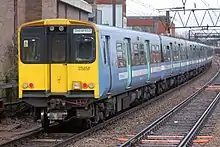

The current operator of the fleet is are TfL Rail, who operate the units on Shenfield metro services on weekdays only.
Most of the withdrawn Class 315s were scrapped, but some TfL Rail Class 315s were temporarily moved to London Overground as a temporary measure and were in operation until the Class 710 was fully introduced.
Replacement
In July 2015, TfL confirmed that it would place a £260m order for 45 units Class 710 "Aventra" trains, which would replace London Overground Class 315. The Class 710 "Aventra" will be introduced on the West Anglia Routes, taken over from Abellio Greater Anglia in May 2015, in 2018.[7] The first units on the Lea Valley lines entered service on 3 March 2020 after a first attempt on 24 February 2020.[8]
Additionally, TfL Rail Class 315s were replaced by new Class 345 "Aventra" trains from August 2017.[9] On 20 October 2018, the first retired unit, 315850, was hauled to C F Booth of Rotherham to be scrapped.[10]
Fleet details
| Class | Operator | No. Built | Year Built | Cars per Unit | Unit nos. |
|---|---|---|---|---|---|
| Class 315 | TfL Rail | 16 | 1980–1981 | 4 | 315818–820, 315826, 315834, 315837–839, 315844, 315847–848, 315851, 315853–854, 315856–857 |
| Stored | 1 | 315809 | |||
| Scrapped | 44 | 315801–808, 315810–817, 315821–825, 315827–833, 315835–836, 315840–843, 315845–846, 315849–850, 315852, 315855, 315858–861 |
Named units

Some units have names, these are as follows:[11]
- 315817: Transport for London (unit scrapped)
- 315829: London Borough of Havering Celebrating 40 years (unit scrapped)
- 315845: Herbie Woodward (unit scrapped)
- 315857: Stratford Connections (denamed)
References
- "News Desk" (PDF). Railway Herald (125). 21 March 2008. p. 4. Archived from the original (PDF) on 9 October 2011. Retrieved 15 July 2011.
- "Class 315". Eversholt Rail Limited. Archived from the original on 3 February 2020. Retrieved 3 February 2020.
- Class 315 Electric Multiple Unit Archived 11 November 2013 at the Wayback Machine - Eversholt Rail Group. Retrieved 24 December 2013.
- New brand, new name, new era Archived 17 November 2015 at the Wayback Machine - National Express Group. Retrieved 14 September 2014.
- National Express invests in upgrade of class 315 fleet - Archive of National Express East Anglia. Retrieved 23 November 2018.
- First refurbished Class 315 units enter service Archived 1 February 2016 at the Wayback Machine - Greater Anglia. Retrieved 24 December 2013.
- Rail Magazine, Issue 778, Page 14
- "Bombardier Class 710/1s finally make their passenger debut on West Anglia suburban routes". Rail. 4 March 2020. Archived from the original on 13 March 2020. Retrieved 4 March 2020.
- Clinnick, Richard (13 September 2017). "Peak-time use for Crossrail's new trains". Rail. Bauer Media Group. Retrieved 29 January 2021.
- Devereux, Nigel (3 December 2018). "First Class 315 goes for scrap". Railway Magazine. Archived from the original on 29 November 2020. Retrieved 20 January 2019.
- "FAbRail Rail Databases – Electric Multiple Units". abrail.co.uk. Archived from the original on 21 January 2019. Retrieved 20 January 2019.
| Wikimedia Commons has media related to British Rail Class 315. |